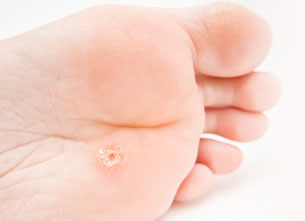- Home
- Foot & Ankle Conditions
- Plantar Warts
Plantar Warts: symptoms, causes and treatments

What are plantar warts?
Plantar warts are rough, hardened warts that grow in the outer layers of skin on the soles of the feet. Unlike other types of warts, such as filiform warts, which can appear on the neck, or periungual warts found on the hands, plantar warts only affect the feet—making podiatrists the best choice for plantar wart treatment!
Typically, they appear on the areas of your feet that bear the most weight: the balls and heels. Due to the pressure from the foot, plantar warts may start to grow inward instead of outward, causing them to appear as flat warts instead of raised foot bumps or lumps. Sometimes, these skin-colored warts may also develop under a callus.
Also known as verrucas, plantar warts are caused by the same virus that causes common warts: the human papillomavirus (HPV). There are two plantar wart types: singular and mosaic, the latter being where several plantar wart lesions fuse in a cluster. Plantar warts are common in children, but they can affect adults too. Despite their prevalence, most plantar warts don’t require invasive treatment.
-
Dr. Hamed Jafary is a Board-Certified Podiatric Foot and Ankle Specialist by the American Board of Podiatric Medicine (ABPM). He specializes in trauma, reconstructive surgery, Charcot reconstruction, Ilizarov external fixation, and sports medicine. He is also a member of the American Board of Foot and Ankle Surgery and the American Board of Pediatric Medicine.
When not tending to patients at University Foot and Ankle Institute, Dr. Jafary utilizes his surgical expertise assisting those less fortunate. As a member of the Yucatan Crippled Children Foundation, he has traveled to Mexico several times and performed hundreds of limb correction surgeries on children with disabling foot and ankle disorders.
 Dr. Franson and the PT staff are amazing. I had surgery for my Plantar Faciitis and then several months of PT after. The surg...Wendy H.
Dr. Franson and the PT staff are amazing. I had surgery for my Plantar Faciitis and then several months of PT after. The surg...Wendy H. I had quadruple bunion and neuroma surgery November 2017 and I have more pain now than I ever had before the surgery. I follow...Anne B.
I had quadruple bunion and neuroma surgery November 2017 and I have more pain now than I ever had before the surgery. I follow...Anne B. Great experience. Great communication. Great direction for my care. Very happy I chose to go with this particular doctor and o...Christopher R.
Great experience. Great communication. Great direction for my care. Very happy I chose to go with this particular doctor and o...Christopher R. Great service and care. Highly recommend Dr. Franson.David B.
Great service and care. Highly recommend Dr. Franson.David B. If you have to go see a Doctor than this is a great experience.Frank M.
If you have to go see a Doctor than this is a great experience.Frank M. My doctor was great. Really greatRudolph B.
My doctor was great. Really greatRudolph B. Good.David E.
Good.David E. Your Santa Barbara office and Dr. Johnson always give me excellent care!Jayne A.
Your Santa Barbara office and Dr. Johnson always give me excellent care!Jayne A. Dr. Gina Nalbadian was amazing!! I came in with an emergency foot situation and she had wonderful bedside manner and resolved m...Danielle C.
Dr. Gina Nalbadian was amazing!! I came in with an emergency foot situation and she had wonderful bedside manner and resolved m...Danielle C. I was frustrated that after 3 weeks I still hadn’t heard back about my PT referral status. And I did sit in a room for over 30 ...Sarah C.
I was frustrated that after 3 weeks I still hadn’t heard back about my PT referral status. And I did sit in a room for over 30 ...Sarah C. I’m very pleased with Dr. Kelman.Alan S.
I’m very pleased with Dr. Kelman.Alan S. I injured my foot last night while kickboxing. I was afraid I broke it. I called Dr.Babak Baravarian's of the Foot and Ankle ...Michael C.
I injured my foot last night while kickboxing. I was afraid I broke it. I called Dr.Babak Baravarian's of the Foot and Ankle ...Michael C.
-
 Listen Now
The Power of Pediatric Flexible Flatfoot Procedures
Read More
Listen Now
The Power of Pediatric Flexible Flatfoot Procedures
Read More
-
 StimRouter: A Revolutionary Approach to Targeted Pain Relief
Read More
StimRouter: A Revolutionary Approach to Targeted Pain Relief
Read More
-
 Listen Now
Why Are My Feet Different Sizes? It's More Common Than You Think
Read More
Listen Now
Why Are My Feet Different Sizes? It's More Common Than You Think
Read More
-
 Listen Now
Flip-flops Causing You Pain? Protect Your Feet This Summer!
Read More
Listen Now
Flip-flops Causing You Pain? Protect Your Feet This Summer!
Read More
-
 Listen Now
Is Barefoot Running Better? Or are you Running Toward Injury?
Read More
Listen Now
Is Barefoot Running Better? Or are you Running Toward Injury?
Read More
-
 Listen Now
The Link Between Foot Health and Posture
Read More
Listen Now
The Link Between Foot Health and Posture
Read More
-
 Listen Now
An Inside Look at Shockwave Therapy for Heel Pain, now available in Valencia, CA
Read More
Listen Now
An Inside Look at Shockwave Therapy for Heel Pain, now available in Valencia, CA
Read More
-
 Listen Now
How to Choose Running Shoes: 6 Essential Steps
Read More
Listen Now
How to Choose Running Shoes: 6 Essential Steps
Read More
-
 Listen Now
Custom Orthotics vs. Over-the-Counter Inserts: Which Are Best for Your Feet?
Read More
Listen Now
Custom Orthotics vs. Over-the-Counter Inserts: Which Are Best for Your Feet?
Read More
-
 Listen Now
9 Running Tips from Sports Medicine Experts
Read More
Listen Now
9 Running Tips from Sports Medicine Experts
Read More
-
 State-of-the-Art CT Scanning, Now in Our Office
Read More
State-of-the-Art CT Scanning, Now in Our Office
Read More
-
 Listen Now
Revealing the Secrets of Men's and Women's Shoe Sizes: Why Are They Different?
Read More
Listen Now
Revealing the Secrets of Men's and Women's Shoe Sizes: Why Are They Different?
Read More
-
 Listen Now
Common Foot Problems In Aging Feet: What To Watch Out For
Read More
Listen Now
Common Foot Problems In Aging Feet: What To Watch Out For
Read More
-
 Listen Now
Revolutionizing Extremity Imaging: UFAI's Open MRI for the Foot and Ankle
Read More
Listen Now
Revolutionizing Extremity Imaging: UFAI's Open MRI for the Foot and Ankle
Read More
-
 Listen Now
If the Shoe Fits, Wear it… Especially for Kids Shoes!
Read More
Listen Now
If the Shoe Fits, Wear it… Especially for Kids Shoes!
Read More















